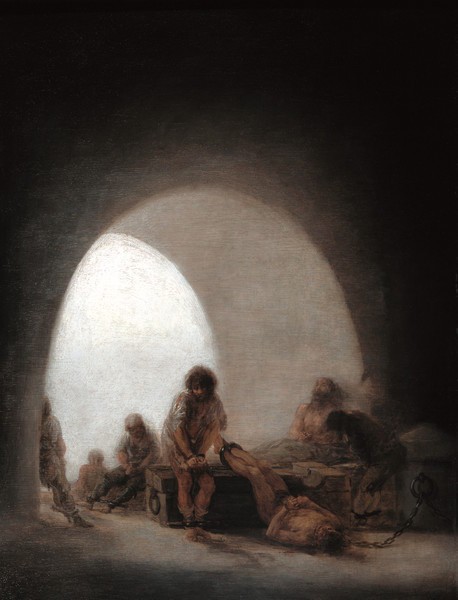- Cronología
- 1793 - 1794
- Ubicación
- The Bowes Museum, Barnard Castle, United Kingdom
- Dimensiones
- 42.9 x 31.7 cm
- Técnica y soporte
- Oil on tin
- Reconocimiento de la autoría de Goya
- Undisputed work
- Titular
- The Bowes Museum
- Ficha: realización/revisión
- 13 May 2010 / 14 Jun 2023
- Inventario
- (29)
This work came from the collection of the Count of Quinto, Madrid. It was acquired by J. Bowes in 1862.
This work may have belonged to the set of paintings that Goya made during his stay in Cádiz at the home of Sebastián Martínez and which he presented at the Royal Academy of Fine Arts of San Fernando in Madrid in January 1794 (see rec. no.).
The scene takes place inside a prison cell, in which we can see light pouring in through an archway, a visual device that brings to mind that used in the work Children Playing at Bullfighting.
Inside this room, Goya has painted a number of prisoners, lying down, sitting on the ground and leaning against the walls, fettered with handcuffs and shackles, and all of them dressed in rags, if at all. These are miserable, dejected men, themselves as surely imprisoned by fear and desperation as their arms and legs are by the chains and manacles. Goya emphasized the importance of these elements by placing at the centre of the composition the shackles which bind the feet of the prisoner lying on the ground, well lit by the light coming in through the archway.
We do not know whether the artist had the opportunity to visit a real prison or whether he was told of the state of these places by others, but we do know that he took a keen interest in the situation that prisoners found themselves in. It is quite likely that he would have read the text by Cesare Beccaria (Milan, 1738-Milan, 1794) entitled On Crimes and Punishments (Dei delitti e delle pene) (1764). In this treatise, the Italian author called for the abolition of the death penalty and proposed measures to humanize the punishments employed in prisons. He stated the need for policies which aimed to prevent crimes rather than ones which focussed chiefly on dishing out punishments, in most cases disproportionate ones at that, for them.
Goya's interest in the work of Beccaria would also be seen in some of the etchings in his Disasters of War series, in which he portrays a number of brutal executions (for example, no. 14, The way is hard! (Duro es el paso!), and no. 15, And it can't be helped (Y no hai remedio)).
-
Exposición conmemorativa del centenario de GoyaPalacio de OrienteMadrid1946organized by Patrimonio Nacional. June 1946cat. 50
-
cat. 57
-
Goya and his timesThe Royal Academy of ArtsLondon1963cat. 66cat. 102
-
Goya y el espíritu de la IlustraciónMuseo Nacional del PradoMadrid1988from October 6th to December 18th 1988. Exhibited also at Museum of Fine Arts, Boston, January 18th to March 26th 1989; The Metropolitan Museum of Art, Nueva York, May 9th to July 16th 1989, Madrid curator Manuela B. Mena Marqués, scientific directors Alfonso E. Pérez Sánchez and Eleanor A. Sayrecat. 71
-
Goya. El Capricho y la Invención. Cuadros de gabinete, bocetos y miniaturasMuseo Nacional del PradoMadrid1993from November 18th 1993 to February 15th 1994. Exhibited also at the Royal Academy of Arts, London, March 18th to June 12th 1994 and The Art Institute of Chicago, Chicago, July 16th to October 16th 1994, consultant editors Manuela B. Mena Marqués and Juliet Wilson-Bareaucat. 42
-
Goya's RealismStatens Museum for KunstCopenhagen2000from February 11th to May 7th 2000pp. 156-157, nº 32
-
Goya: Prophet der ModerneAlte NationalgalerieBerlin2005from July 13th to October 3th 2005. Exhibitied also at the Kunsthistorischemuseum, Vienna, October 18th 2005 to January 8th 2006, consultant editor Manuela B. Mena Marquéscat. 31
-
Goya en tiempos de guerraMuseo Nacional del PradoMadrid2008consultant editor Manuela B. Mena Marqués, from April 14th to July 13th 2008cat. 3
-
Goya et la modernitéPinacothèque de ParisParís2013from October 11st 2013 to March 16th 2014cat. 148
-
GoyaBasle2021p. 149
-
L'œuvre peint de Goya. 4 volsParís1928-1950p. 238, cat. 207
-
Vie et ouvre de Francisco de GoyaParísOffice du livre1970p. 264, cat. 929
-
BarcelonaPolígrafa1970vol. I, pp. 321, cat. 470
-
L’opera pittorica completa di GoyaMilanRizzoli1974p. 125, cat. 532
-
Goya y el espíritu de la IlustraciónMadridMuseo del Prado1988pp. 268 y 269 (il.), cat. 71
-
Goya. Arte e condizione umanaNaplesLiguori editore1990pp. 155-156, il. 134
-
Goya. El capricho y la invención. Cuadros de gabinete, bocetos y miniaturasMadridMuseo del Prado1993pp. 200, 201, 202, 203, 208 (il.), cat.
-
Los mundos de Goya (1746-1828)BarcelonaLunwerg2008il. 141
-
Goya's prison: the year of despairBowes Museum2009
